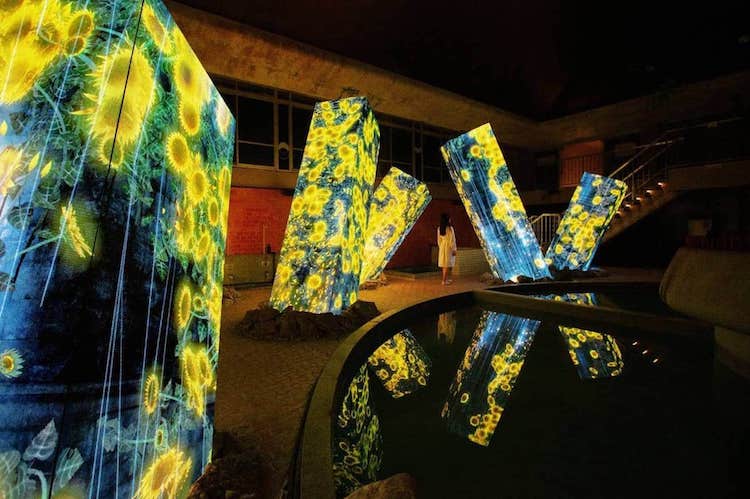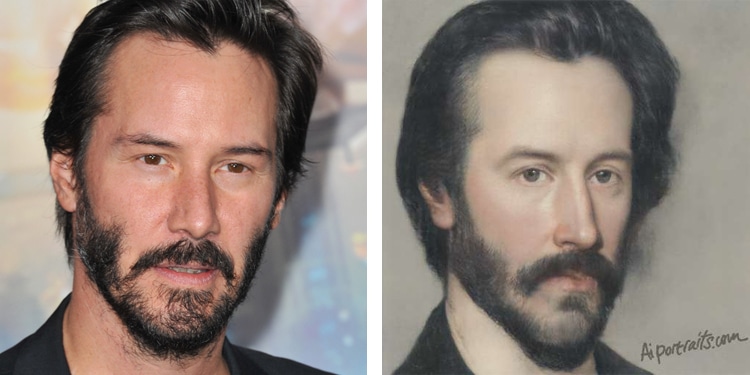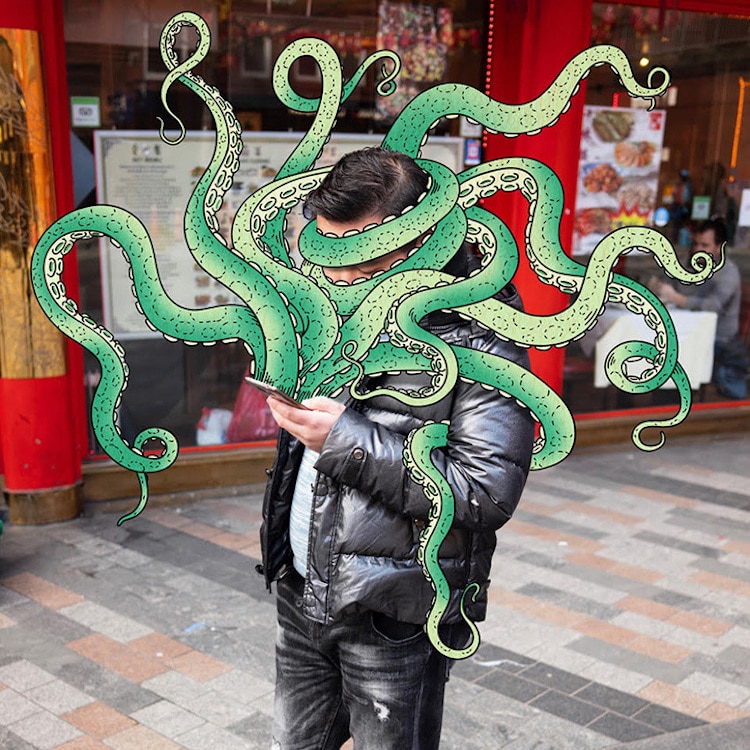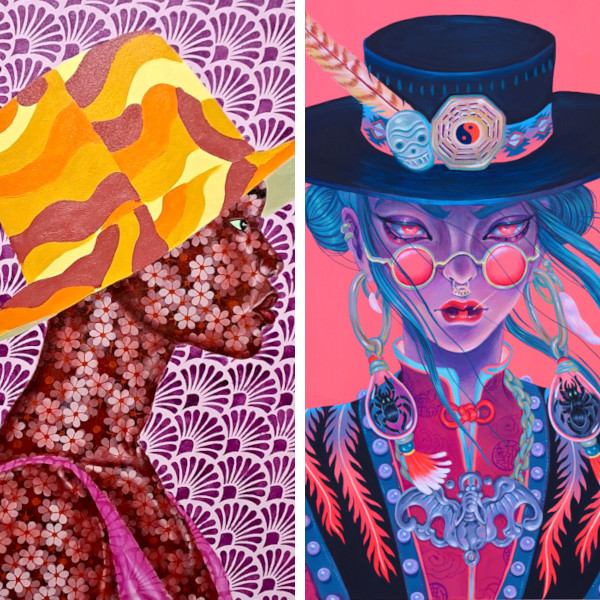
The word “technology” might evoke images of laser beams, modern computers, and streams of data, but innovative engineering spans decades. Artists have always used technology as new ways to express themselves. Without the invention of the paint tube, perhaps the Impressionists would never have painted en plein air. And where would Andy Warhol have been without silkscreen printing?
Over time, art and technology have become more and more intertwined, with many contemporary artists adopting new types of media to create their work. From laser-printed ceramics to code-generated paintings, digital artists are using technology to push the boundaries of traditional practices.
This past year, we’ve seen artists use machinery to generate exciting new artwork, such as New York based BREAKFAST, who invented its own, motorized medium called Brixels. This year has also shown us how advanced artificial intelligence is and what that means for fine artists and photographers. Ultimately, there’s no denying technology’s influence on the arts today. Here’s a look at some of the best tech-inspired art projects of 2019.
Check out the top 10 technology-inspired art projects of 2019.

© Culturespaces : E. Spiller
Starry Night Exhibition by Culturespaces
This year, Culturespaces brought Vincent van Gogh’s paintings to life. The brilliant team turned an exhibition space into a living painting that made it feel as though visitors were physically stepping into Van Gogh's paintings. In order to take these pieces to new heights, artistic director Gianfranco Iannuzzi opted to outfit the space with 140 state-of-the-art laser video projectors. Music wafting from 50 speakers also set the mood of the space, culminating in a fully immersive “sensorial, musical, and aesthetic experience” for art lovers of all ages.
Read more: This Exhibit Gives Visitors the Experience of Stepping Inside Van Gogh’s Paintings
View this post on Instagram
Alternatives by Espen Kluge
The nature of code-generated art typically results in geometric, abstract shapes, but Norwegian artist Espen Kluge manages to render portraits. For his fascinating series, titled Alternatives, the tech-driven artist developed his own algorithm that takes in photographs as inputs and then turns them into colorful, vector-based portraits. The code loops through the pixels in the raster image and chooses some at random. Then, it generates lines in between each pixel to create the strange, three-dimensional thread art effect. Kluge never knows how a piece will end up. “It’s impossible for me to have these things in my head before I start,” he says. “I would like to think this is true for all generative artists. It is a very playful process.”
Discover more about Kluge's work on his website.
Awaken 1 by BREAKFAST
BREAKFAST is a New York-based art collective that combines science, mechanical engineering, and aesthetic beauty to create interactive installations. The team invented their own kinetic medium called Brixels—motorized brick-shaped “pixels” that can rotate in either direction. In one of their 2019 pieces, titled Awaken 1, BREAKFAST created a mirrored wall made up of 168 Brixels that move according to a person's movements. The mesmerizing piece can be used as a canvas by “drawing” with your hand in the air, and explores human interaction with robotics. Watch Awaken 1 in action above.

Megaliths in the Bath House Ruins by teamLab
Japanese art and tech studio teamLab is known for its technology-driven installations that transform public spaces into interactive playgrounds. Their 2019 artwork, titled Megaliths in the Bath House Ruins, features a series of “megaliths” that appear to have burst through the ground of the abandoned bathhouse from another dimension. Each tower-like structure acts as a canvas for protected artwork that changes over time, depending on the interaction of visitors in the room. “The artwork is continuously rendered in real time by a computer program,” explains teamLab. “It is neither prerecorded, nor on loop. As a whole, previous states never recur, and the artwork is continuously changing due to the movement of people. Every moment is unique and can never be seen again.”
Read more: Immersive Nature Art Projections Emerge on Megaliths in a Japanese Bath House

Generated Photos by Icons8
Artificial intelligence has made it easier than ever to produce images that look completely real but are totally fake. Icons8 is a company who wants to put these types of pictures to use, and so they’ve created Generated Photos, a resource of 100,000 AI-generated faces that are royalty-free. These AI-generated portraits could rival the real people you see in stock photos.
Read more: AI Creates 100,000 Computer-Generated Faces That Look So Incredibly Real
View this post on Instagram
Coded Art by Manolo Gamboa Naon
Argentinian artist Manolo Gamboa Naon creates colorful digital artworks using code. He experiments with different programming languages such as Processing, Openframeworks, Unity, vvvv, Puredata, and Javascript to create futuristic artworks that often look like images of cells under a microscope. Every artwork is born from an error. “The error is central to the work of generative artists apart from, obviously, the rules, and the rules become text that converts into an image,” he explains. “It is impossible to have what you imagine become what you see. The beginning is errors, errors, errors, errors. They are beautiful errors.”
Find more from Naon's portfolio on Instagram.
View this post on Instagram
3D-Printed Vases by Oliver van Herpt
Dutch ceramicist Oliver van Herpt pushes the boundaries of 3D printing technology by merging both digital and analogue processes. He designed his own industrial machine that prints with clay (rather than plastic) to produce digitally manufactured vases. Despite the tech-driven process, Van Herpt’s collection is still designed with traditional pottery in mind. His 3D printer features sensors that help to mimic shapes and textures from surrounding external factors. The result is beautiful, unique ceramics that are printed with random imperfections.
“When we replaced the craftsmen by machines we lost the translation of local influences into our products,” says Van Herpt. “What if our machines could become more sensory? What if the machine could sense the local environment and incorporate it into the production process?”
Learn more about Van Herpts innovative projects on his website.

Keanu Reeves. (Photos: Stock Photos from Featureflash Photo Agency/Shutterstock (left) and AI Portraits (right))
AI Portraits by MIT-IBM Watson AI Lab
AI Portraits uses information from over 45,000 15th-century masterpieces to help “paint” the portrait of any photo that’s uploaded. It truly combines the past and the present, art and technology. AI Portraits actually determines the best style for the portrait by analyzing the features and the background. This makes for completely unique and artful 4K portraits done in the style of the Old Masters.
Read more: This Website Uses AI to Transform Any Picture into a 15th-Century Portrait

Phone Buddies by Andrew Rae
Illustrator Andrew Rae highlights the all-too-familiar sight of people consumed by their mobile devices in his 2019 series, Phone Buddies. Rae digitally draws over photographs (taken by his friend Ruskin Kyle) of people on their phone, to make it look like fantastical beasts are emerging from their smartphone screens. “I’d draw objects or creatures coming out of the phones and looking back at us,” he says. “The different styles of the photograph and the drawing would make sense together, as the phone screen is like a portal where the real world and the digital world meet.”
Read more: Artist Draws Monsters Bursting Out of Phones of People Staring at Their Screens
View this post on Instagram
All Doors Open by Doug Aitken
Also inspired by our technology-driven world, American artist Doug Aitken created a sculptural installation titled All Doors Open. Featuring a female figure slumped over a table, lazily reaching for her smartphone, the objects of the scene are illuminated by the neon blue light, while the rest of the stage remains dark. Aitken explains the scene as an “anticipation for information,” where the sitter is “caught in the midst of a silent moment.” The poignant piece is part of the artist’s exhibition, Return to the Real, on view at the Victoria Miro Gallery in London until December 20, 2019.
Read more: Luminescent Sculptures Explore Our Relationship to a World Dominated by Technology
View this post on Instagram
Memories of Passersby I by Mario Klingemann
German artist and “neurographer” Mario Klingemann creates AI-inspired art that explores creativity, culture, and perception through machine learning. His series, Memories of Passersby I, is generated from a machine that the artist designed himself. It produces “old master”-style portraits of people that continuously morph and change while you look at them. “Since I taught myself programming in the early 1980s I have been trying to create algorithms that are able to surprise and to show almost autonomous creative behavior,” says Klingemann. “The recent advancements in artificial intelligence, deep learning and data analysis make me confident that in the near future ‘machine artists' will be able to create more interesting work than humans.”
Find out more about Klingemann's technology-driven practice here.
Related Articles:
World War II Submarine Base in France Transformed Into World’s Largest Digital Art Center
Giant Inflatable Sculptures Merge Technology and Art at San Francisco’s Exploratorium
Artist Transforms VHS Tapes and Obsolete Technology Into Striking Portraits
Cutting Edge Art and Technology Installations at STRP Biennial Defy Boundaries of Space






















































































